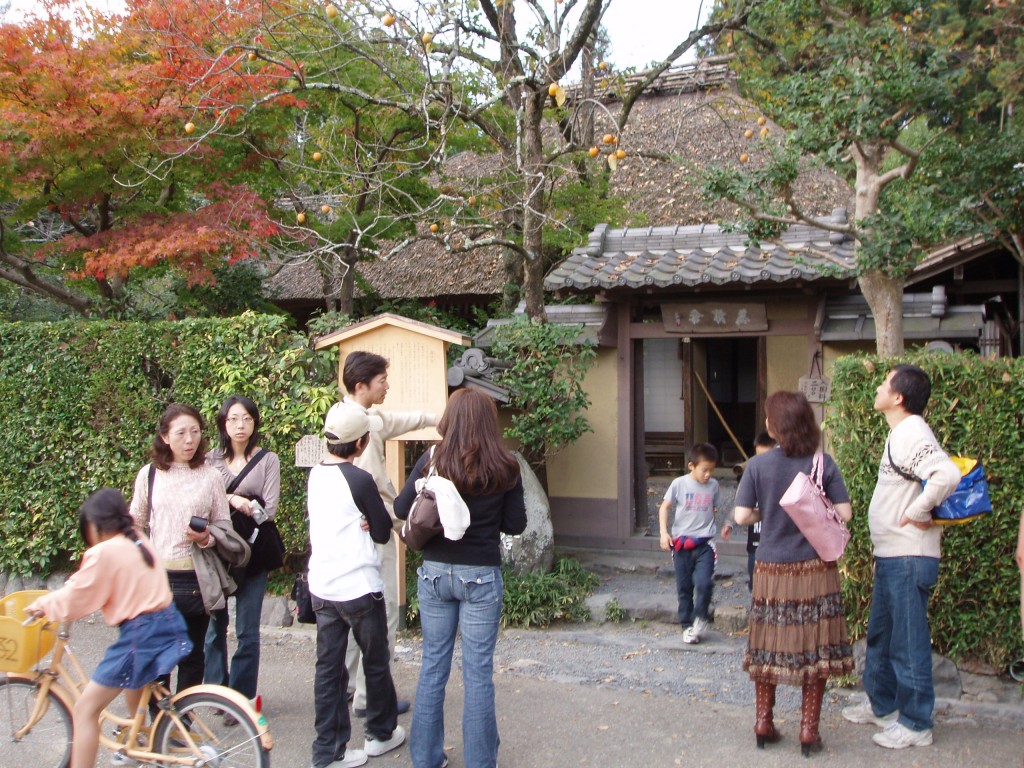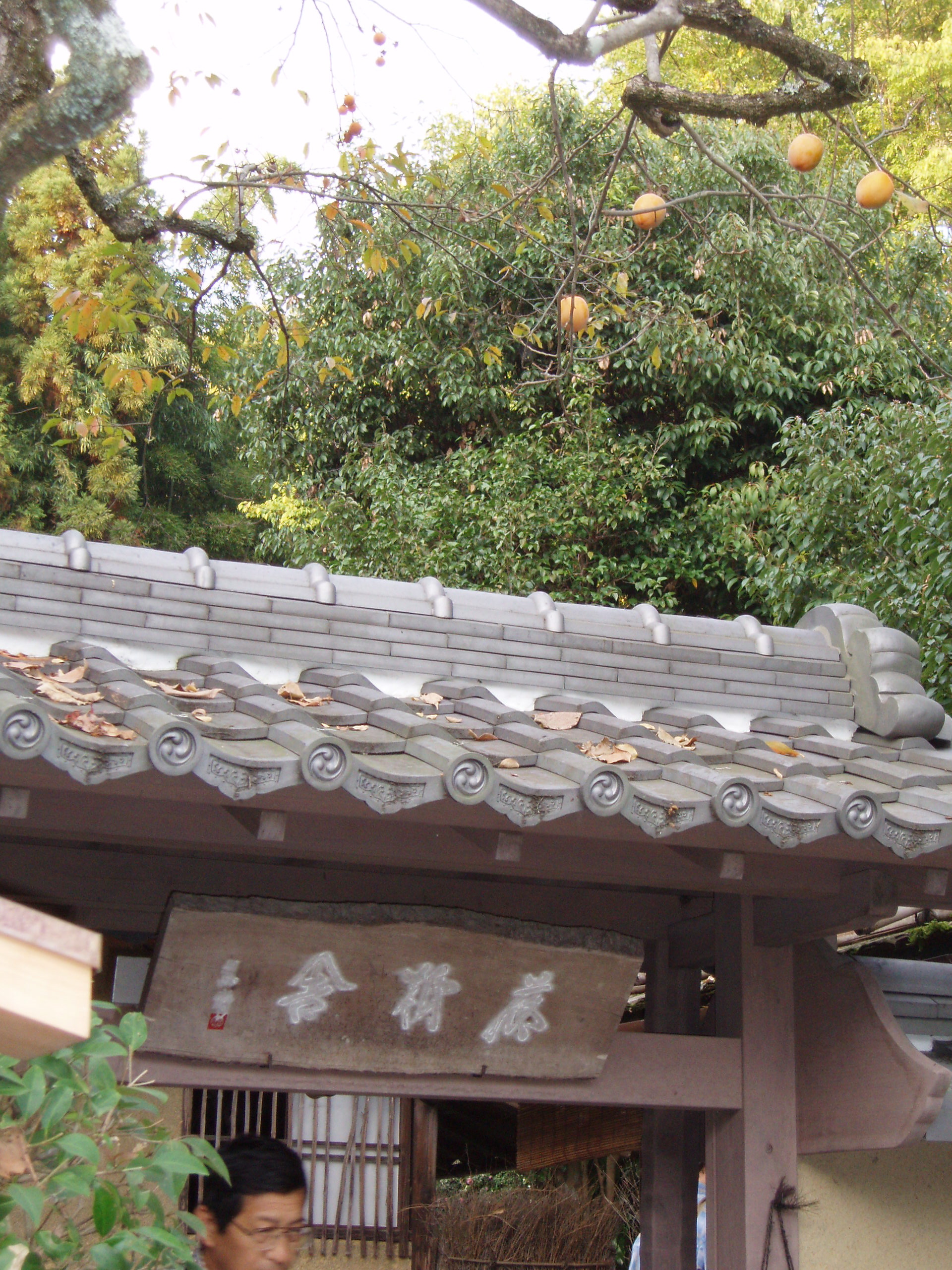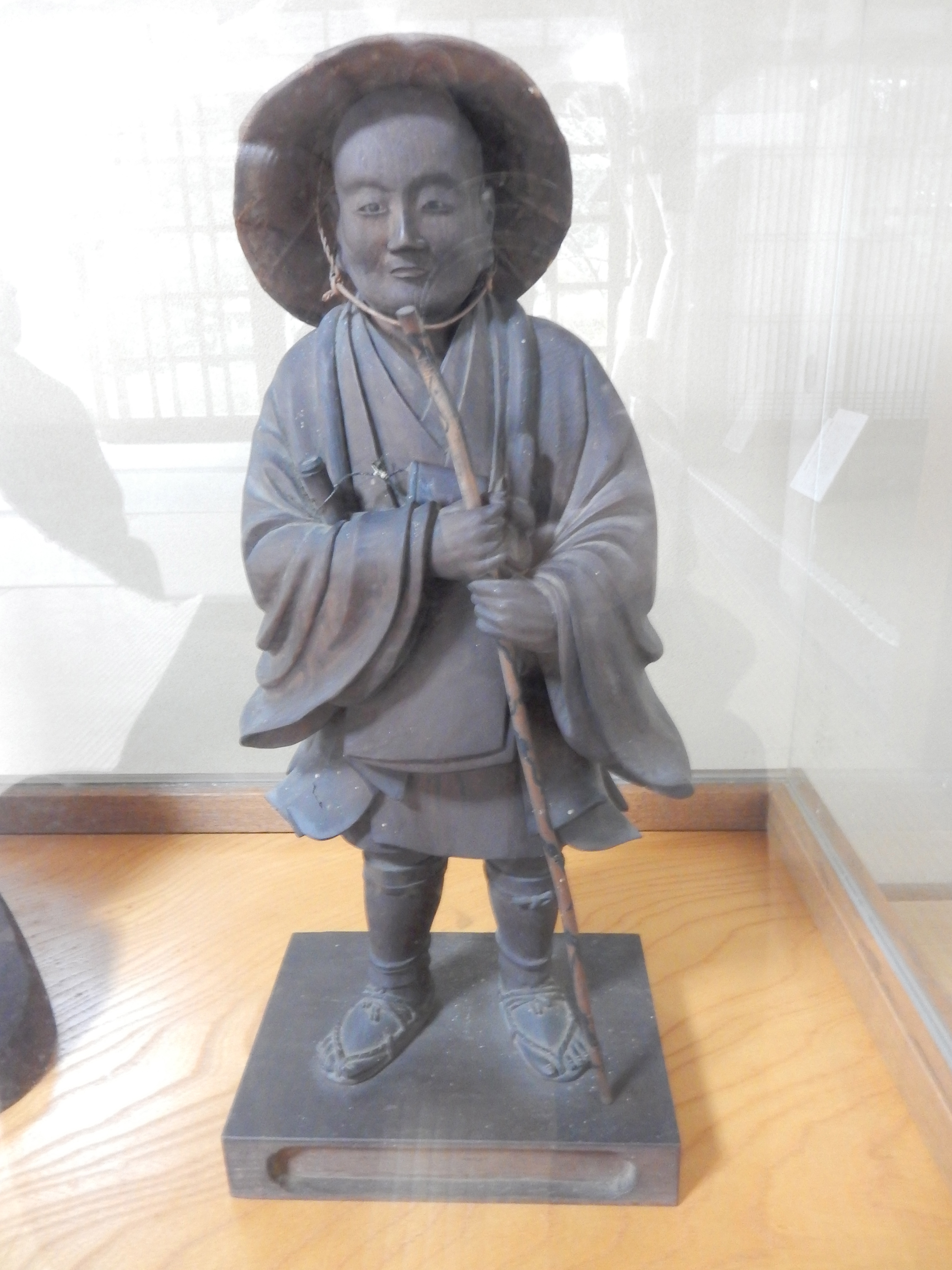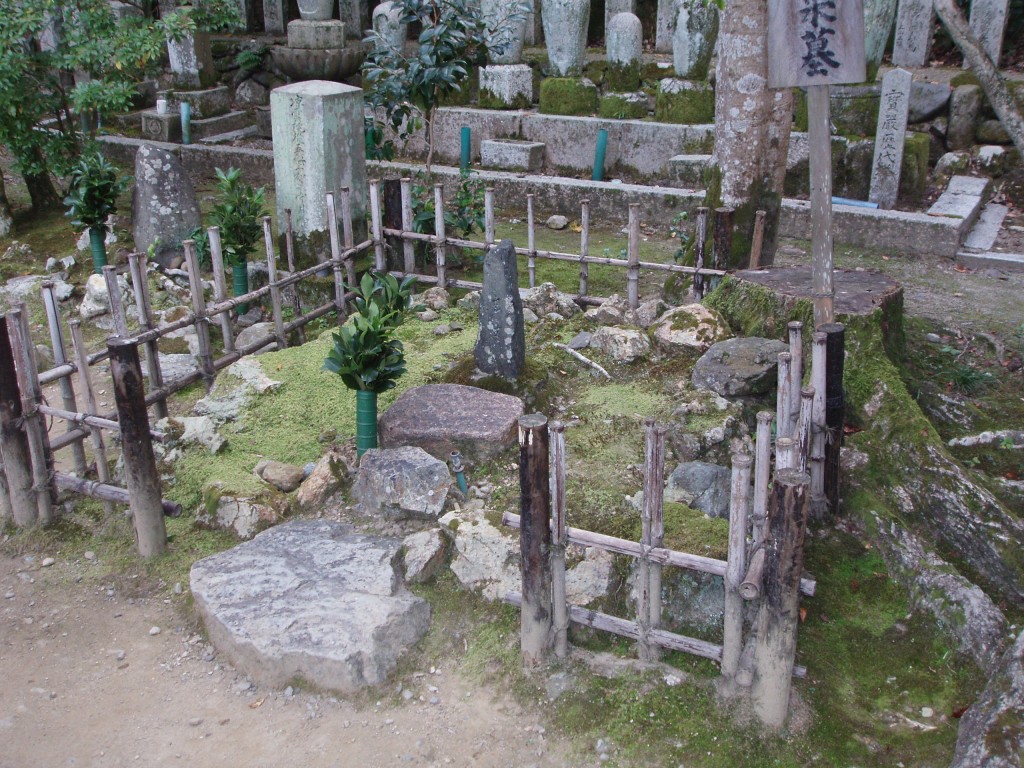
BASHO IN SAGA
Eight Basho haiku, one renku, seven passages of prose and two of his letters,
Translations and Commentary by Jeff Robbins Assisted by Sakata Shoko
N.B. Basho’s own words appear in bold
******************
Basho’s follower Kyorai, the second son of a doctor of Chinese medicine in Kyoto, had a cottage in Saga on the western outskirts.
Basho stayed here for 16 days in 1691 and three weeks in 1694.
The one in Kyoto named Kyorai has a cottage in lower Saga within a bamboo grove, at the base of Mount Arashi, close to the flowing Katsura River. It is a convenient place for leisure, a place where the heart can clear.
Called the River Oi in Basho’s time; I call it by its modern name, the Katsura which bounds the Kyoto area on the west and south.
One autumn Kyorai planned to pick the persimmons hanging over the roof the next day, but you know, man, he did not get around to it, and the rain that night knocked them to the ground, so he called the place “House of Fallen Persimmons.”
This Kyorai is a really lazy guy and the grass stands high before the window, while persimmon trees stick out over the roof.
Summer rains leaking everywhere, tatami mats and paper doors smell of mold, and finding a place to sleep is not so easy.
Sounds like Kyorai was a hippie. On his first day in the cottage, Basho went to see “traces” of a woman. Passages from the Saga Diary are dated according to the Western calendar:

May 16 –
We visit Rinsen Temple. The Katsura flows before, while the heights of Mount Arashi continue from the right down to Matsuo village. Many people come and go to the Kokuzo. Among the bamboos of Matsuo is said to be where Lady Kogo hid herself in a cottage, although altogether there are three places up and down Saga which make this claim, and the true site cannot be determined. Matsuo is where Nakakuni stopped his horse, the so-called “Horse-stopping Bridge”, so for the while, shall we say this is it?
Kogo was taken as a courtesan by the Emperor Takakura already married to the daughter of Kiyomori, chief of the Heike clan ruling Japan. Kogo hid from Kiyomori’s rage in an isolated cottage in Saga with many enormous bamboo groves. The anguished emperor sent a palace guard named Nakakuni to search for her. Kogo was a virtuoso on the koto or 13 string harp which suggests the sensitivity in her heart. Nakakuni rode all around Saga until the sound of her koto brought his horse to a stop on a bridge.
Three places in Saga claim to be the site of Kogo’s cottage, but Basho is not one to be fooled by some tourist trap on the other side of town from the Horse-stopping Bridge. Kogo returned with Nakakuni to the Capital, but when Kiyomori found out she was back, he was furious. He forced her into a nunnery and she later threw herself into the river.
Her grave lies in a bamboo grove next to Sangenya and by the gravestone is a cherry tree. Graciously she awoke and slept on embroidered silk only to become dust and rubbish among bamboos. Willows in the village of King Sokun, Blossoms at the Shrine of the Goddess Fujo, the past fills my thoughts.
The final sentence reaches to the Outer Limits of Obscurity: an old Chinese poem compares the arch of willow branches in the village where King Sokun was born to a lady’s eyebrows; and the blossoms at the shrine of the goddess Fujo to crimson lipstick; this sketch of Kogo’s face — just her eyebrows and lips (a motif often seen in modern advertising) — fills Basho’s thoughts.
Nodes of sorrow—
to become bamboo shoots
at her end
Each of the nodes at regular intervals along stems of bamboo forms a solid disk throughout the diameter of the stem, while between the nodes is hollow. Thus a section of bamboo cut below a node will hold pens and pencils. The expression “to grow in nodes of sorrow” suggests that life moves along smoothly but every so often come to a solid mass of sorrow. Kon speaks of Lady Kogo “tossed about in the world, finally to be buried in a bamboo grove where she changed into bamboo shoots, the end of her road so pathetically sad.”
May 17 –
HototoGIsu
through great bamboo grove
moonlight trickles
The towering bamboos form a cathedral of green, with the moonlight trickling through; the clear bright five-note call of the little cuckoo punctuates the feeling of divine presence.
Clapping my hands
day breaks in the echoes
summer moon
While Basho was in Saga, he helped Kyorai and another follower Boncho compile a major anthology of the Basho school, Monkey’s Raincoat, to be published later that summer. So Basho would not be lonely, either Kyorai and Boncho stayed the night. On May 16th, Boncho spent the night. His wife, Uko who is a nun, came out to the cottage the next day.

The nun Uko arrives for a festival in North Saga. Kyorai also came out from Kyoto. Kyorai’s brother’s wife sent us cakes and side dishes.
Come here again
strawberries will brighten
Saga Mountain
This verse by Uko is the only haiku by a woman in Basho’s published prose. Uko demonstrates the traditional role of women in Japanese society: providing hospitality. Instead of putting forth her own experience, Uko focuses on Basho, welcoming him to Kyoto and Saga by saying that whenever he comes here, strawberries will redden to celebrate his presence.
Tonight Uko and husband stay over and with five people lying up and down in one mosquito net
The fifth person may be either the delivery guy who brought the cakes from Kyorai’s house, or a fellow named Yohei who lives next door and is caretaker of the cottage when Kyorai is not here. The mosquito net is a special one, made for fishermen to set up over the river, so it’s pretty big – two tatami mats, about 6 foot square. They appear to be lying in alternating directions, “up and down,” my shoulders near your knees, for efficient use of space. In Japan both genders may sleep in the same room, in separate parts of the tatami floor, with no thought of sex. Still, five adults spread out inside one mosquito net is bound to get interesting, especially when one is a woman and furthermore a nun, and there is also her husband who is a doctor, their Poetry Master, the guy who owns the cottage, and someone else, presumably of a lower social class, but they all lie down together in one mosquito net.
. . .even though it is night we cannot sleep so after midnight we each come out from the net, bring out the day’s cakes and sake cups, then till the approach of dawn our talk grows light. . .
No one gets any sleep though, so they “each come out from the net” and eat some cakes and drink some sake until everyone gets light and happy and they party till dawn. They sound like college students.
These are not the Japanese Ruth Benedict portrays in The Chrysanthemum and the Sword, all taken up in working off obligations, stiff with the dictates of hierarchy and proper behavior, males always dominating females. Basho says ‘lighten up’ on the issues of obligation, hierarchy, custom, and gender—or maybe that Japanese society was not so severe as Western writers portray it, or maybe that the crowd Basho hangs out with was exceptionally loose.
With daylight Uko and Boncho went back to Kyoto while Kyorai stayed on.
Here are three stanzas of linked verse written in succession by Boncho, Basho, then Kyorai:
His carriage pulls in
the neighbor’s gateway
“Fickle one,
under hedge of spikes
you must crawl!”
Now, before he leaves,
she hands him his sword
She wants him tonight, but is sick and tired of him playing around with other women, so she has closed her front gateway (double meaning alert). He parks his vehicle in the neighbor’s spot to go in a side door. Between the two properties stands a hedge of a tall citrus scrub whose branches divide into twigs ending in inch-long daggers. She thinks “If you want me, suffer as much pain as you caused me!!” According to Kyorai, the man passed through the ordeal, and they slept together. A samurai always carries his sword – except in bed. In the morning, the woman hands him the “sword” which is the manhood he lost last night crawling on the dirt like a worm. He crawls back under the hedge to his carriage and leaves. The cycle is complete.
Good for nothing
I just want to sleep
noisy bird
The reed warbler adds its irritating squawk, day or night, to the overall oppressiveness of the summer season. The scholar Kons elaborates: “One exhausting endless summer day, having done nothing for days, with no talent for anything, I just want to sleep – but a reed warbler starts to squawk so I cannot. Oh! reed warbler, won’t you stop squawking for a bit.”
Basho’s friend Tokoku, his traveling companion for four months in 1688, died in 1690 aged 30. Basho’s diary entry for May 25:
In dreams Tokoku appeared and weeping awoke me. Time shared with the spirit becomes a dream.
When yang is exhausted, we dream of fire; when yin declines, we dream of water.
When Yang, the hot, active aspect of the universe, is exhausted, we dream of fire to replenish it — a weakness of Yin, the cold, passive, and hidden part, is replenished by a dream of water. Basho says that through dreams we regulate our own health.
My dreams are not those of saints or gentlemen.
All day long the illusions scatter about,
and in the night shadows, dreams are just the same.
Truly to see Tokoku in a dream
can be called a dream of remembrance.
He followed me to my old village
where my aspirations began, and at night
we lay down and got up on the same floor.
He helped me in the toil of a pilgrimage,
for a hundred days he followed me like my shadow.
At times we had fun, at times we were sad.
His intentions dyed the lining of my heart.
The words are so very simple, at first they seem not to mean much, however, because they are so simple, they can, if we let them, take on deep personal and social meaning. The image of “dyeing the (kimono) lining,” women soaking fabric in dye to color it before sewing together the two layers of a kimono, adds romantic beauty to the prose. Basho applies this active female image to the innermost places in his heart. Recalling the fun and sadness we shared, friendship soaks the layers inside my heart.
May 29
Sora has come to visit: his pilgrimage to the blossoms at Yoshino and the Kumano Shrine went well. We spoke of old friends and followers in Edo, this and that mixed together. With the evening sun we rode a boat up the Katsura River past Mount Arashi to the rapids at Tonase. It began to rain and with evening falling, we returned to the cottage.
May 30
Last night’s rain continued to fall all day and night without stopping. Together listening and speaking more about those in Edo, finally it dawned.
May 31
Not having slept last night, I lie down and sleep all day. Around noon, the rain stopped.
Long summer rains—
poetry cards peeled off,
traces on the wall
While it rains for hours, walking around the cottage before leaving it, Basho notices on the wall some rectangular spaces less discolored than the rest of the wall; that a former resident pasted his favorite poetry cards here and removed when he left; in these “traces” remaining from a consciousness here long ago, Basho imagines the lovely fair-weather scenes in the poems no longer there.
After his sojourn in Saga in 1691, Basho returned to Edo for more than two years. In summer of 1694 he again came west to the Kyoto area. Here he is on his way again to Kyorai’s cottage:
Wicker basket’s
cool weight on one shoulder
first musk melon
The sensations in this verse are remarkable: the coolness of round melon seeping through the willow-branch basket on one shoulder, the body adjusting to compensate for the extra weight on one side, the anticipation of sharing the sweet juicy melon with good friends when he arrives.
On July 24th at the House of Fallen Persimmons, Basho wrote in a letter to his neighbour Ihei at home in Fukagawa near Edo:
These days impoverished followers of mine from Kyoto and Osaka gather about and we eat up all the food in the house and spend our time with great laughter.
Basho sounds like a fun guy who enjoys eating and laughing with young people. Makota Ueda translates this passage,
“Penniless students of mine in Kyoto and Osaka rush here one after another these days: they eat all the food available and spend their time in loud laughter.”
In Ueda’s words, Basho is not a part of the eating, drinking and laughing; he sounds like a fussy old man annoyed with his followers. The Japanese (as usual) is vague; it can be taken either way — Basho eating and laughing with them, or Basho annoyed at their eating and laughter – but Japanese Language Instructor Shoko can see no sign of annoyance in the original. Ueda’s translation is heavy, coming from the “no-fun” Basho image. Our translation is light and leads to “Dear Uncle Basho.”
On the 23rd day of the Intercalary 5th Moon — July 15, 1694 –Basho in Saga sent his follower Shiko presents and a letter :
The two things you sent with your best wishes will be most valuable, especially on a journey. Today Kyorai was cleaning the pipe for me, and this being the first time he did this, “pipe cleaning” shall be a seasonal reference to the Intercalary 5th Moon.
One of the presents Shiko sent was a kiseru, a long thin pipe with bamboo shaft and metal mouthpiece and bowl. The bowl is tiny, only big enough for two or three inhales. Wikipedia says “Kiseru were used for smoking a fine, shredded tobacco, as well as cannabis.” (Before World War II, cannabis was often smoked both for recreation and medicine.) Basho makes the absurd suggestion that ‘pipe cleaning’ become a reference to the Intercalary 5th Moon because the illustrious non-smoker Kyorai cleaned a kiseru for the very first time during this Intercalary 5th Moon. So, when the next Intercalary 5th Moon comes in twenty or thirty years, it will be remembered as the season of Kyorai cleaning the kiseru. How ridiculous! but then that’s par for the course in this letter.
You sent your other present in the wrong season so from now on, it too will refer to this season.
Always remember what you have learned here. This evening why don’t you come visit me?
Basho
p.s. In fact, by chance, at this time last year in Bufu, I forgot my gaiters so now shall “gaiters” set the season?
“Bufu” is a funny-sounding way to say the province where Edo is. Gaiters made out of straw or cloth, are worn to protect the lower legs while travelling. If Basho was smoking cannabis there in Kyorai’s hippie cottage, that helps to explain his bizarre sense of humor.
Here beside the river in Saga, Basho wrote this haiku:
River Katsura
no dust in the ripples
summer moon
Basho’s ideal of Purity seen in moonlight on flowing water.
Five months later, after midnight on November 24, on his deathbed in Osaka wrote his famous haiku about dreams wandering about on withered fields. He went to sleep; when he awoke the next day, he asked Shiko
“do you remember this summer, when I was in Saga that verse about the Katsura River?”
Basho told Shiko to revise that verse to:
Clear Cascade
into the ripples fall
green pine needles
This was actually Basho’s final poem, although scholars do not count it as such. Because the season in the poem is summer while the season in reality was winter, scholars say CLEAR CASCADE does not belong to the end of Basho’s life; it appears in the chronology of Basho poetry in summer where nobody notices it. Basho, however, wrote the verse upon waking from sleep, so it appears to record his dream. In sleep Basho left his sick old body dying in the cold winter night to dream-travel back to summer in Saga beside the raging river. As a dream-haiku, this verse does belong to this early winter night and is Basho’s death verse.
The pine needles, still green and full of life, fall into the rushing water, swirl about and rush away, leaving no traces of their existence. The flow never returns and what is gone is gone forever.
You can visit the replica of Kyorai’s cottage a fifteen-minute walk from JR Saga Arashiyama Station. Google “House of Fallen Persimmons” to find various prose accounts and many pictures.
******************************
Author’s afterword:
I request your assistance in getting out the word on the warm affectionate Basho who wrote hundreds of poems about women and children about friendship, love, and compassion in works unknown to the world, yet the most pro-female, child-centered, life-affirming works in old-time literature.
Feedback will be greatly appreciated.
Basho4now@gmail.com
*******************************
For Jeff’s previous posting, see his piece on Basho’s Shijo haibun.

